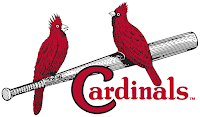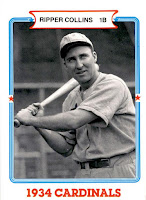James Wilson
Philadelphia Phillies
Catcher-Manager
Born: July 23, 1900, Philadelphia, PA
Major League Teams: Philadelphia Phillies 1923-1928; St. Louis Cardinals 1928-1933; Philadelphia Phillies 1934-1938; Cincinnati Reds 1939-1940
World Series Appearances: St. Louis Cardinals 1928, 1930-1931; Cincinnati Reds 1940
As a Manager: Philadelphia Phillies 1934-1938; Chicago Cubs 1941-1944
Died: May 31, 1947, Bradenton, FL (46)
Catcher Jimmie (or Jimmy, depending on the source) Wilson was a two-time All-Star and a two-time World Series winner, spending four seasons as a player-manager with the Phillies in the mid-1930s. Nicknamed "Ace," Wilson was the regular catcher for the 1931 World Champion Cardinals and was the starting catcher for the National League in the first ever All-Star Game in 1933. He hit a career high .325 in 1929, perhaps his best full season in the majors. Wilson began his managerial career with the Phillies in 1934 while also serving as the team's part-time catcher. He was a coach with the Reds at the end of his career and was pressed into action for a few games in 1939 and 1940 when the team was in need of a catcher. At 39 years old, he starred for the Reds in the 1940 World Series, batting .353 (6 for 17) and helping the club defeat the Tigers in seven games.
A fine defensive back-stop, Wilson still ranks on several all-time leaders lists among catchers for 1,351 games behind the plate (49th all-time), 931 assists (61st), a caught stealing percentage of 47.9% (45th) and double plays turned with 153 (9th). For his career, he batted .284 with 1,358 hits, 32 home runs and 621 RBIs.
Building the Set
March 6, 2021 from Mom's Tax Returns - Card #12
Accountant by day and blogger about old baseball cards by night, my chosen profession has led me to annually prepare my Mom's tax returns. I don't charge her of course, but she still insists on some type of payment for my troubles. I'm primarily a Phillies baseball card collector, but I'm slowly running out of vintage (and affordable) Phillies baseball cards for me to suggest to her as payment. Mixing things up this year, I let her know I had decided to collect the Diamond Stars set from the mid-1930s and that to date I had only 10 cards. She went off on her online scavenger hunt, and I was the beneficiary of two more cards for my Diamond Stars set in exchange for preparing her tax returns. That's a pretty good deal. On a visit on day in early March, she handed over her tax documents and then prepaid for my services with this card and the Tom Bridges (#5) card which I featured last week.
Variations Available
1 - 1934 / green back / 1933 statistics / 1934 copyright
2 - 1935 / green back / 1934 statistics / 1934 copyright ✅
3 - 1936 / blue back / 1935 statistics / 1934 copyright
The Card / Phillies Team Set
I'm assuming the artist coloring Wilson's photo for this card did not realize the Phillies hat and Old English "P" were both red. Wilson's pose is also demonstrating the write-up on the back, encouraging catchers to "keep the fingers of his bare hard curled, or closed in a fist," to avoid injury. I guess this is before the days catchers starting keeping their non-glove hands behind their backs.
1935 Season
In his second season as the Phillies' catcher/manager, Wilson appeared in 93 games and batted .279 while the team went on to finish in 7th place with a record of 64-89. Wilson yielded most of his catching playing time to veteran Al Todd, who appeared in 107 games and batted .290. Wilson and the Reds' Chuck Dressen were the opposing managers in the first ever major league night game, held at Cincinnati's Crosley Field on May 24th. During the season, Wilson convinced Bucky Walters to move from infielder to pitcher. Walters would go on to have a Hall of Fame-caliber career, winning 198 games over a 16-year career.
The Phillies acquired Philadelphia-native Wilson in February 1923 in a trade with New Haven in the Eastern League. Never quite earning the permanent starting job during his first stint in Philadelphia, Wilson shared catching duties with Butch Henline between 1923 and 1926, before getting more regular playing time in 1927. He made history in 1928, as explained by this passage in his SABR biography:
"In 1928, Wilson started the season hitting a solid .300 by early May. This would be the year he entered baseball history in an unusual way. On May 1, St. Louis Cardinal general manager Branch Rickey unexpectedly traded his All-Star catcher, Bob O’Farrell, to the New York Giants. The Cardinals now found themselves in need of a dependable catcher. Ten days later, on May 11, Rickey offered three players to the Phillies for Jimmie Wilson: Spud Davis, Homer Peel, and Don Hurst. The Phillies accepted the offer. The team was playing a doubleheader in St. Louis that day. Wilson caught the entire first game and had started the nightcap. During the second inning, Phillies manager Burt Shotton called time and took Wilson out of the game. Shotton informed him that he was now a Cardinal. He went into the Cardinals clubhouse, changed into a Cardinal uniform, and sat on the Cardinals bench for the reminder of the game, becoming the only player in major league history who was a member of two teams during one game."
On November 15, 1933, the Phillies re-acquired Wilson from the Cardinals sending Davis back to St. Louis along with Eddie Delker. The popular Wilson was also named the club's new manager, taking over for the departing Shotton. He oversaw one of the worst periods in Phillies history, managing a club that went 280-477 over a five-year period finishing in either 7th or 8th place each season. Still a skilled player, Wilson was again the starting catcher for the N.L. All-Stars in 1935. Following the 1938 season, in which he only appeared in 3 games as a player, Wilson was let go and he signed as a player/coach with the Reds on May 5, 1939. For his time with the Phillies, over 11 seasons as a player, Wilson appeared in 838 games and batted .288.
|
|
|
|
|
Other Notable Baseball Cards
First Mainstream Card: 1927 Playing Cards (W560)
Topps Flagship Set Appearances (0): N/A
Most Recent Mainstream Card: 1993 Conlon Collection TSN #874
55 - Wilson non-parallel baseball cards in the Beckett online database as of 3/23/21.
Sources:
Previous Card: #21 Johnny Vergez - New York Giants
Next Card: #23 Bill Hallahan - St. Louis Cardinals


































